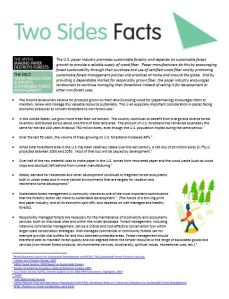 When it comes to the sustainability of the Graphic Communications Value Chain, it’s important to separate verifiable facts from opinions and misleading information. Fortunately, Two Sides (www.twosides.us) has the resources that can help.
When it comes to the sustainability of the Graphic Communications Value Chain, it’s important to separate verifiable facts from opinions and misleading information. Fortunately, Two Sides (www.twosides.us) has the resources that can help.
Two Sides has posted nine new 2-page Fact Sheets related to the sustainability of print and paper. Written in clear, easy-to-understand language and including citations to verifiable sources, these Fact Sheets make it easy to understand that print, paper, and packaging have a great environmental story to tell.
Below you’ll find a quick summary of each of the nine new Fact Sheets, plus a link leading to the fact sheet itself. Please feel free to share these valuable resources with colleagues, customers, students and local media. You can be part of Two Sides’ efforts to end the harmful practice of “greenwashing” (using inflated, inaccurate, or misleading data to misrepresent environmental performance). Check out the facts, then click through for the downloadable Fact Sheets:
FACT: “Go Green – Go Paperless” and “Save-a-Tree” claims are misleading and may not meet best practices for environmental marketing. These marketing messages ignore the highly sustainable nature of print on paper – it comes from a renewable resource, is recyclable and recycled more than any other commodity in the U.S. and has great carbon characteristics. Learn More
FACT: Anti-paper environmental claims are often inaccurate and should be challenged. After research showed that more than half of America’s leading banks, utilities and telecommunications companies are using misleading anti-paper environmental marketing claims, Two Sides began its “myth-busting” campaign. To date, more than 40% of those contacted have eliminated unsubstantiated anti-paper claims from their marketing. Learn More
FACT: E-Media also have environmental impacts. A recent study estimates that developing countries will produce at least twice as much electronic waste (e-waste) as developed countries within the next six to eight years. Uncontrolled toxic emissions can result from the informal recycling practices often used in the developing world; these emissions can include dioxins, furans, and cyanide. Learn More
FACT: The carbon footprint of paper is not as high as you may think. The U.S. forest products industry is a leader in the production of renewable energy, with more than 65% of the on-site energy needed to produce paper products derived from carbon-neutral biomass. Learn More
FACT: Sustainable forest management benefits people and the planet. In addition to replenishing the supply of recycled fiber, the U.S. paper industry’s perpetual use of trees harvested from responsibly managed forests has a host of economic, social and environmental benefits. Learn More
FACT: Paper is one of the most recycled products in the world. In 2012, nearly 51 million tons or 65.1% of the paper used in the United States was recovered for recycling, up 76% since 1990. The industry’s new recovery goal is to exceed 70% by 2020. Learn More
FACT: Most of the energy used to make pulp and paper is renewable. The print and paper industry accounts for only 1% of global carbon dioxide emissions; at a global level, the greenhouse gas emissions from the forest products industry value chain are largely offset by sequestration in forests and forest products. Learn More
FACT: Paper is one of the few truly sustainable products. Paper is made from a natural resource that is renewable, recyclable and compostable; in the United States, paper is recycled more than any other commodity in the municipal solid waste stream, including plastics, glass and metals. Learn More
FACT: Paper supports sustainable forest management. The income U.S. landowners receive for products grown on their land—including wood for papermaking—encourages them to maintain, renew and manage this valuable resource sustainably, instead of converting forestland to non-forest uses. Learn More
Led by sustainable and responsible forestry, paper production and printing, the U.S. Graphic Communications Value Chain is working to ensure that, in a world of scarce resources, print and paper’s unique recyclable and renewable qualities can be enjoyed for generations to come. By sharing these Fact Sheets, you can help Two Sides U.S. and its member companies strengthen the paper, packaging, print, and related industries—and make an important contribution to real environmental sustainability. Find more resources, plus information on how to become a member company, at www.twosides.us.
